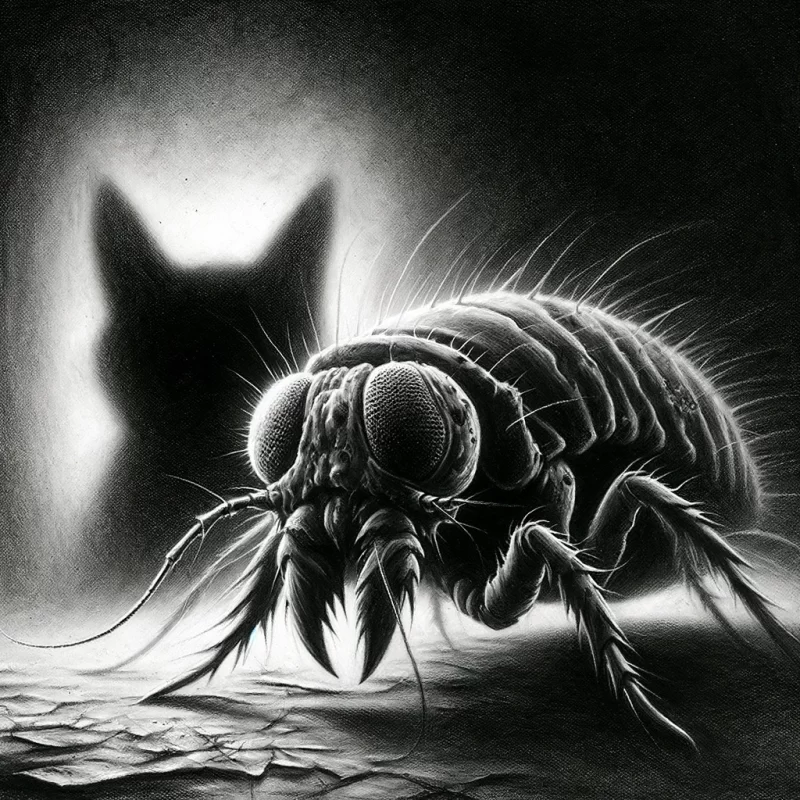Blog
Sustainable Flea Prevention in Cats Made Easy

Sustainable methods for flea prevention in cats ensure eco-conscious care. Discover safe, effective ways to protect your feline friend.
As responsible cat owners, we must ensure the well-being of our feline companions. One crucial aspect of their health is flea prevention. However, in our pursuit of keeping our cats safe, we must also consider the environmental impact of our products. This article will explore sustainable flea prevention methods that protect cats and minimise environmental harm.
Understanding Fleas and Their Impact
Fleas are a nuisance for our furry friends and can cause various health issues. These tiny parasites can make our cats miserable, causing skin irritations and allergic reactions. Traditional flea prevention methods often involve using chemical-based products that can harm both cats and the environment. It’s time to shift our focus towards sustainable alternatives.
Flea-Transmitted Diseases in Cats: Understanding the Risks
Fleas not only cause discomfort and irritation to our feline companions but can also transmit various diseases. Cat owners must be aware of these potential health risks and take proactive measures to prevent them. This chapter will explore some typical cat flea-transmitted diseases and the importance of flea prevention in mitigating their impact.
Bartonellosis (Cat Scratch Disease)
Bartonellosis, also known as Cat Scratch Disease, is caused by the bacteria Bartonella henselae, which can be transmitted to cats through flea bites. Infected cats may exhibit symptoms such as fever, lethargy, swollen lymph nodes, and, in severe cases, even neurological issues. It is important to note that humans can also contract Cat Scratch Disease from infected cats through scratches or bites.
Tapeworm Infections
Fleas serve as intermediate tapeworm hosts, and cats can become infected by ingesting fleas during grooming. Tapeworm infections can cause weight loss, poor coat condition, and irritation around the anus. Infected cats may also pass tapeworm segments in their faeces, which are visible to the naked eye.
Flea Allergy Dermatitis (FAD)
Flea Allergy Dermatitis is an allergic reaction to flea saliva that affects some cats. A flea bite can trigger intense itching, leading to excessive scratching, hair loss, and skin infections. Cats with FAD may develop open sores and scabs due to their relentless scratching, making them more susceptible to secondary bacterial infections.
Hemoplasmosis
Hemoplasmosis, also known as feline infectious anaemia, is caused by bacteria that infect red blood cells. Fleas can transmit these bacteria to cats through their bites. Infected cats may experience anaemia, weight loss, lethargy, and pale gums. Hemoplasmosis can be particularly dangerous for kittens, elderly cats, or those with weakened immune systems.
Importance of Flea Prevention in Mitigating Disease Risks
Preventing flea infestations is crucial in reducing the risks of flea-transmitted diseases in cats. By implementing a comprehensive flea prevention plan, including regular grooming, natural repellents, vet-prescribed flea treatments, and maintaining a clean living environment, we can significantly minimise the chances of our cats contracting these diseases.
Additionally, it is essential to consult with a veterinarian for guidance on the most suitable flea prevention methods for your cat. They can recommend safe and effective topical treatments or oral medications that specifically target fleas and reduce the risks of disease transmission.
In conclusion, understanding the potential risks of flea-transmitted diseases in cats highlights the importance of proactive flea prevention measures. By protecting our cats from fleas, we ensure their well-being and contribute to a healthier and safer environment for our feline companions and ourselves. Let’s prioritise flea prevention as an integral part of responsible cat ownership and safeguard the health of our beloved pets.

Natural Remedies for Flea Prevention
Regular Grooming:
Brushing your cat’s fur regularly helps remove fleas and their eggs. Additionally, it strengthens the bond between you and your feline companion.
Regular grooming is a bonding experience between you and your feline companion and a sustainable and effective means of flea prevention. By brushing your cat’s fur regularly, you remove fleas and their eggs and reduce the need for chemical-based treatments. This natural approach keeps your cat’s coat healthy and shiny and minimises the environmental impact of traditional flea prevention methods. Embrace the power of regular grooming to keep your cat flea-free and the planet thriving.
Diatomaceous Earth:
This natural powder, made from fossilised algae, is an effective and eco-friendly way to combat fleas. Sprinkle it on your cat’s bedding and other areas where fleas may hide.
Diatomaceous Earth, a natural powder made from fossilised algae, is a sustainable and eco-friendly solution for cat flea prevention. You create a barrier dehydrating and killing fleas without harmful chemicals by sprinkling this fine powder on your cat’s bedding and other areas where fleas may hide. Not only is Diatomaceous Earth effective in combating fleas, but it is also safe for your cat and the environment. Embrace this natural remedy as a sustainable alternative to traditional flea prevention methods and ensure the well-being of your cat while minimising your ecological footprint.
Essential Oils:
Essential oils like lavender and cedarwood have natural flea-repelling properties. Dilute a few drops in water and spray it on your cat’s fur (avoiding the face) for a chemical-free solution.
Essential oils, such as lavender and cedarwood, offer a sustainable and chemical-free approach to cat flea prevention. These natural oils have flea-repelling properties that can be harnessed by diluting a few drops in water and spraying it on your cat’s fur (avoiding the face). By opting for essential oils, you not only protect your cat from fleas but also minimise the environmental impact of traditional chemical-based treatments. Embrace the power of nature and provide your cat with a safe and sustainable solution for flea prevention.
Herbal Flea Collars:
Opt for herbal flea collars using plant ingredients like citronella and eucalyptus. These collars are effective and safe for your cat and the environment.
Herbal flea collars are a sustainable and effective alternative for cat flea prevention. These collars are made with plant-based ingredients like citronella and eucalyptus, which naturally repel fleas. By opting for herbal flea collars, you can protect your cat from fleas without using harmful chemicals that can harm your cat and the environment. These collars provide long-lasting flea protection and a sustainable solution that aligns with your commitment to eco-friendly practices. Embrace the power of herbal flea collars to keep your cat safe and the environment thriving.
Flea Prevention Products
Spot-On Treatments:
Please look for spot-on treatments labelled eco-friendly or made from natural ingredients. These products are designed to kill fleas without harming the environment.
Spot-On Treatments are a reliable and sustainable option for flea prevention in cats. These treatments are designed to be applied directly to your cat’s skin, targeting and eliminating fleas effectively. Look for spot-on treatments labelled as eco-friendly or made from natural ingredients, ensuring they are safe for your cat and the environment. Choosing spot-on treatments can provide long-lasting protection against fleas without compromising sustainability. Embrace the convenience and effectiveness of spot-on therapies to keep your cat flea-free while minimising your ecological footprint.
Oral Medications:
Some oral medications are now available that provide long-lasting flea protection for cats. You should consult your veterinarian for a sustainable option that suits your cat’s needs.
Oral medications offer a sustainable and convenient solution for flea prevention in cats. These medications, available through consultation with your veterinarian, provide long-lasting flea protection without needing topical applications. By opting for oral medications, you can protect your cat from fleas while minimising the environmental impact associated with traditional chemical-based treatments. Embrace the power of oral medications to keep your cat safe and free from fleas while prioritising sustainability and the planet’s well-being.
Flea Combs:
Invest in a high-quality comb to physically remove fleas from your cat’s fur. Regular combing can help prevent flea infestations and reduce the need for chemical treatments.
Flea combs are a sustainable and effective tool for flea prevention in cats. Investing in a high-quality flea comb allows you to physically remove fleas from your cat’s fur, reducing the need for chemical treatments. Regular combing helps prevent flea infestations, promotes a healthy coat, and strengthens the bond between you and your feline companion. By incorporating flea combing into your grooming routine, you can take a natural and sustainable approach to flea prevention, minimising the environmental impact of traditional methods. Embrace the power of flea combs to keep your cat flea-free while prioritising sustainability and their overall well-being.
Flea Treatment Shampoos:
A reliable and effective solution for eliminating fleas and keeping your feline companion healthy.
These specially formulated shampoos are designed to target and kill fleas on contact, providing immediate relief from infestations. Look for shampoos containing ingredients like pyrethrin or permethrin, which are known for their efficacy against fleas. When using flea treatment shampoos, follow the instructions carefully and ensure the product is specifically formulated for cats, as some ingredients can be toxic.
By incorporating flea treatment shampoos into your cat’s grooming routine, you can effectively combat fleas and restore their comfort while prioritising their well-being and maintaining a flea-free environment.
Additionally, when using flea treatment shampoos for cats, it’s essential to consider the environmental impact of the packaging. Opt for shampoos that come in recyclable containers or bottles made from recycled materials.
After using the shampoo, remember to recycle the packaging to minimise waste and contribute to a more sustainable future. By making conscious choices when selecting and disposing of flea treatment shampoo packaging, we can ensure that our efforts in flea prevention align with our commitment to the environment. Let’s prioritise sustainability in caring for our cats, including the products we use and how we dispose of them.
Environmental Considerations
When choosing flea prevention products, it’s essential to consider their environmental impact. Look for biodegradable products made from sustainable materials with minimal packaging. Additionally, always follow the instructions for properly disposing of unused or expired products.
Spot-On Treatments are a reliable and sustainable option for flea prevention in cats. These treatments are designed to be applied directly to your cat’s skin, targeting and eliminating fleas effectively. Look for spot-on treatments labelled as eco-friendly or made from natural ingredients, ensuring they are safe for your cat and the environment. You can provide long-lasting protection against fleas without compromising sustainability by choosing spot-on treatments. Embrace the convenience and effectiveness of spot-on therapies to keep your cat flea-free while minimising your ecological footprint.
Sustainable flea prevention in cats is not only beneficial for our furry friends but also for the planet we call home. By adopting natural remedies, using eco-friendly products, and being mindful of our environmental impact, we can ensure the well-being of our cats while preserving the Earth’s delicate balance. Let’s make a conscious choice to protect our cats and the environment they thrive in.

Which is the best flea treatment for cats?
When choosing the best flea treatment for your cat, it’s essential to consider several factors. First, you’ll want to look for a product specifically formulated for cats. Cats have different sensitivities and metabolisms than other animals, so using a treatment meant for dogs or other animals can harm your cat.
Second, choosing an effective treatment that kills adult fleas and prevents their infestation is crucial. Look for products containing ingredients like fipronil or imidacloprid, which are effective against fleas. These ingredients target the fleas’ nervous system, leading to their demise.
Furthermore, consider the best application method for you and your cat. Some treatments come in topical solutions that must be applied directly to your cat’s skin, while others are administered orally as pills or tablets. Choose the method that you and your cat are most comfortable with.
Additionally, the longevity of the treatment should be taken into account. Some products protect for up to a month, while others may offer longer-lasting effects. Assess your cat’s lifestyle, the prevalence of fleas in your area, and your schedule to determine which duration is most suitable.
Always consult with your veterinarian before starting flea treatment on your cat. They can provide expert advice based on your cat’s needs and recommend the best flea treatment option for your furry friend.
Do indoor cats need flea prevention?
Indoor cats may also require flea prevention despite not being exposed to outdoor environments. While they have a lower risk of fleas compared to outdoor cats, it is still possible for indoor cats to get fleas through various means.
Fleas can hitch a ride into your home on clothing, shoes, or other pets. They can also be brought in from outdoor areas such as balconies or gardens. In addition, fleas can be carried by rodents or brought in through open doors or windows.
Implementing flea prevention measures for indoor cats is essential to prevent infestations and their associated problems. Fleas can cause discomfort, itching, and allergic reactions in cats and transmit diseases. Treating your indoor cat with a flea prevention product recommended by your veterinarian can help keep them protected.
Regular flea checks and grooming can also help detect fleas early and prevent infestations from becoming severe. This includes regularly examining your cat’s fur for any signs of flea dirt or live fleas and using a flea comb to remove any fleas that may be present.
Remember, even indoor cats can benefit from flea prevention to ensure their health and well-being. Please consult your veterinarian to determine the most suitable flea prevention method for your cat and maintain a flea-free environment.
How can I prevent my cat from getting fleas?
Preventing your cat from getting fleas is essential for their health and well-being. Here are some expert tips to help you keep your furry friend flea-free.
First and foremost, regular grooming is key. Brush your cat’s fur regularly, which will help you detect any signs of fleas or flea dirt. Additionally, grooming can remove any adult fleas or eggs that may be present on your cat’s coat.
Next, flea prevention products are highly effective in keeping fleas at bay. Consult your veterinarian to find the proper flea prevention treatment for your cat. Topical therapies (topicals), such as spot-on treatments or flea collars, are commonly used and provide long-lasting protection against fleas.
Maintaining a clean and flea-free environment is crucial. Vacuum your home regularly, paying particular attention to areas where your cat spends a lot of time. Washing your cat’s bedding and any other fabrics they come into contact with will also help eliminate fleas and prevent re-infestation.
If you suspect your cat has fleas, taking prompt action is important. Please speak to your veterinarian about suitable flea treatments and follow their recommendations. Remember to treat all pets in your household, as fleas can quickly spread between animals.
In conclusion, preventing fleas in your cat requires a combination of regular grooming, using appropriate flea prevention products, and maintaining a clean environment. Following these expert tips can help keep your cat free from fleas and ensure their ongoing health and happiness.
What flea prevention is safe for cats?
Regarding flea prevention for cats, choosing products that are safe for their well-being is important. Look for vet-recommended treatments like topical spot-ons, oral medications, or flea collars specifically formulated for feline use. Always consult your veterinarian to find the most suitable and effective option for your cat.
Sustainable flea prevention for cats requires a holistic approach that considers both the well-being of our furry friends and the impact on the environment. We can effectively prevent fleas by adopting natural remedies, such as regular grooming, diatomaceous earth, and essential oils while minimising the need for chemical-based treatments. Herbal flea collars and eco-friendly spot-on treatments provide sustainable alternatives that are safe for our cats and the planet. Additionally, proper disposal of used products and choosing biodegradable and minimal packaging options further contribute to our commitment to sustainability. Let’s prioritise the health of our cats and the environment by embracing sustainable flea prevention methods.
How effective are flea collars for cats?
Flea collars for cats can be an effective tool in preventing and controlling flea infestations. These collars are designed to continually release active ingredients that repel and kill fleas on contact. The effectiveness of flea collars can vary depending on the specific product and the severity of the flea problem.
Flea collars with longer-lasting active ingredients, such as those containing insecticides like imidacloprid or flumethrin, tend to provide better and longer-lasting protection. Following the manufacturer’s instructions and replacing the collar as recommended is essential to maintain its effectiveness.
While flea collars can protect against fleas, they may not eliminate an existing infestation alone. Additional treatments, such as topical spot-on solutions or oral medications, may be necessary in cases of severe infestation. Combining different flea control methods can provide a more comprehensive approach to tackling fleas.
It’s crucial to consult with your veterinarian before using a flea collar or any other flea-control product on your cat. They can recommend the best product for your cat’s needs and guide proper usage and potential side effects. Regular flea monitoring and preventive measures, such as keeping your cat’s living environment clean and vacuuming regularly, can also help enhance the effectiveness of flea collars.
When should cats start flea prevention?
Flea prevention should be started in cats at a young age, typically around eight weeks old. It is important to begin flea prevention early to protect cats from flea infestation discomfort and health risks.
Various options are available for flea prevention in cats, including topical treatments, oral medications, and collars. It is recommended to consult with a veterinarian to determine the best flea prevention method for your cat based on their individual needs and lifestyle.
Regular and consistent flea prevention is critical to control and prevent flea infestations in cats effectively. Flea medications should be administered according to the manufacturer’s instructions or as a veterinarian recommends.
In addition to flea prevention, it is also essential to maintain a clean and hygienic environment for your cat. Regularly vacuuming the house, washing bedding, and keeping outdoor areas clean can reduce the risk of flea infestations.
Remember that flea prevention is not a one-time treatment but an ongoing process to protect your cat from fleas. By starting flea prevention early and following a comprehensive prevention plan, you can help ensure the health and well-being of your feline friend.
What are safe flea treatments for kittens?
Safe flea treatments for kittens should prioritise their health and well-being. It is essential to consult with a veterinarian to determine the most suitable flea treatment for your kitten.
When choosing a flea treatment for kittens, avoiding products that contain harsh chemicals or ingredients that could harm their sensitive skin is crucial. Look for treatments specifically labelled as safe for kittens. These products are usually formulated with milder ingredients and are less likely to cause irritation or adverse reactions.
Topical treatments, such as spot-on solutions or sprays, are commonly used to treat fleas in kittens. These products are applied directly to the kitten’s skin and can effectively kill fleas and prevent infestations. However, please follow the instructions carefully to ensure proper dosage and application.
Oral medications can also be an option for flea treatment in kittens. These medications are ingested and work internally to kill fleas. Again, please consult your veterinarian for the best oral medication for your kitten’s age and weight.
It is important to note that some flea treatments for adult cats or dogs may contain toxic ingredients for kittens. Never use a flea treatment intended for adult pets on a kitten. Always choose a product specifically formulated for kittens to ensure their safety.
Regular grooming and cleaning your kitten’s environment can also help control fleas. Vacuuming regularly, washing bedding in hot water, and cleaning the living area can prevent flea infestations.
Remember, the health and safety of your kitten should always be the top priority when choosing flea treatments. Consult a veterinarian to find the most suitable and safe option for your furry friend.
How often should flea treatments be applied?
Flea treatments for cats should be applied regularly to prevent and control flea infestations effectively. It is recommended that flea treatments be used every month for most products. This ensures continuous protection against fleas and helps maintain a flea-free environment for your cat.
When you choose a flea treatment product, please look for those specifically formulated for cats. These products usually come in the form of topical treatments or oral medications. Follow the instructions provided by the manufacturer for the correct dosage and application method.
I want to let you know that the frequency of flea treatment application may vary depending on your cat’s lifestyle, environment, and the severity of the flea problem. If you live in an area with a high flea population or your cat spends much time outdoors, more frequent flea treatments may be required. Consult your veterinarian for advice on your cat’s best flea treatment schedule.
Remember, regular flea treatment is essential to protect your cat from fleas, which can cause discomfort and lead to various health issues. By staying consistent with flea prevention, you can help ensure the well-being of your feline companion.
Are natural remedies effective for fleas in cats?
Are natural remedies effective for fleas in cats?
In 2016, researchers conducted a thorough study to determine if natural remedies can effectively treat fleas in cats. The study found that while some natural remedies showed potential, none effectively eliminated fleas.
One of the challenges with natural remedies is that they often lack the necessary ingredients to kill fleas and their eggs. While some remedies, such as essential oils, may have repellent properties, they do not necessarily eradicate the infestation. Additionally, the concentration of active ingredients in natural remedies can vary, making it difficult to ensure consistent effectiveness.
It is important to note that natural remedies should never be used as a substitute for veterinary care. Fleas can cause various cat health issues, including flea allergy dermatitis and transmission of certain diseases. Consulting with a veterinarian is crucial for a thorough examination and appropriate treatment plan.
In conclusion, while natural remedies may have some potential in managing and preventing flea infestations in cats, they are not a guaranteed solution. Consulting with a veterinarian and following their recommended treatment plan is essential for ensuring the health and well-being of your cat.
Embrace Sustainable Flea Prevention in Cats!
In conclusion, sustainable flea prevention in cats is a crucial aspect of responsible pet ownership. While natural remedies like regular grooming, diatomaceous earth, essential oils, and herbal flea collars offer eco-friendly alternatives, it’s important to acknowledge their limitations. These natural methods may repel fleas but do not provide a permanent solution. Therefore, it is essential to complement sustainable practices with veterinary-prescribed topicals and oral pills that effectively eliminate fleas.
By combining sustainable practices with effective flea treatments, we can keep these pests under control and prevent the potential spread of diseases caused by fleas. It’s important to remember that the environmental impact of dealing with flea-related diseases, meaning increased resource consumption and medical waste, can far outweigh the effects of preventive measures.
As responsible cat owners, let’s prioritise sustainability by choosing eco-friendly flea prevention products with minimal packaging and recyclable containers. Also, let’s properly dispose of unused or expired products by following the instructions.
By embracing sustainable flea prevention practices, we protect our cats from discomfort and potential health issues and contribute to a healthier environment. Let’s consciously try to keep our felines and the planet thriving.









